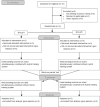Electrically stimulated eccentric contraction during non-weight bearing knee bending exercise in the supine position increases oxygen uptake: A randomized, controlled, exploratory crossover trial
- PMID: 34793521
- PMCID: PMC8601547
- DOI: 10.1371/journal.pone.0259856
Electrically stimulated eccentric contraction during non-weight bearing knee bending exercise in the supine position increases oxygen uptake: A randomized, controlled, exploratory crossover trial
Abstract
It is well known that prolonged bed rest induces muscle weakness, muscle atrophy, cardiovascular deconditioning, bone loss, a loss of functional capacity, and the development of insulin resistance. Neuromuscular electrical stimulation is anticipated to be an interventional strategy for disuse due to bed rest. A hybrid training system (HTS), synchronized neuromuscular electrical stimulation for voluntary exercise using an articular motion sensor, may increase the exercise load though bed rest. We assessed oxygen uptake or heart rate during knee bending exercise in the supine position on a bed both simultaneously combined with HTS and without HTS to evaluate exercise intensity on different days in ten healthy subjects (8 men and 2 women) by a randomized controlled crossover trial. The values of relative oxygen uptake during knee bending exercise with HTS were significantly greater than those during knee bending exercise without HTS (7.29 ± 0.91 ml/kg/min vs. 8.29 ± 1.06 ml/kg/min; p = 0.0115). That increment with HTS was a mean of 14.42 ± 13.99%. Metabolic equivalents during knee bending exercise with HTS and without HTS were 2.08 ± 0.26 and 2.39 ± 0.30, respectively. The values of heart rate during knee bending exercise with HTS were significantly greater than those during knee bending exercise without HTS (80.82 ± 9.19 bpm vs. 86.36 ± 5.50 bpm; p = 0.0153). HTS could increase exercise load during knee bending exercise which is easy to implement on a bed. HTS might be a useful technique as a countermeasure against the disuse due to bed rest, for example during acute care or the quarantine for infection prophylaxis.
Conflict of interest statement
The authors have declared that no competing interests exist.
Figures





Similar articles
-
Electrically Stimulated Eccentric Contractions during Walking Increases Oxygen Uptake.Kurume Med J. 2021 Jul 21;66(2):93-100. doi: 10.2739/kurumemedj.MS662008. Epub 2021 Jun 15. Kurume Med J. 2021. PMID: 34135203
-
Hybrid Training System Consisting of Synchronized Neuromuscular Electrical Stimulation for Voluntary Exercise Using an Articular Motion Sensor.Kurume Med J. 2024 Dec 10;70(3.4):83-89. doi: 10.2739/kurumemedj.MS7034006. Epub 2024 Aug 5. Kurume Med J. 2024. PMID: 39098028 Review.
-
Combined Application of Electrically Stimulated Antagonist Muscle Contraction and Volitional Muscle Contraction Prevents Muscle Strength Weakness and Promotes Physical Function Recovery After Total Knee Arthroplasty: A Randomized Controlled Trial.Kurume Med J. 2020 Jan 23;65(4):145-154. doi: 10.2739/kurumemedj.MS654007. Epub 2019 Nov 13. Kurume Med J. 2020. PMID: 31723080 Clinical Trial.
-
Characteristics of fast voluntary and electrically evoked isometric knee extensions during 56 days of bed rest with and without exercise countermeasure.Eur J Appl Physiol. 2008 Jul;103(4):431-40. doi: 10.1007/s00421-008-0724-8. Eur J Appl Physiol. 2008. PMID: 18386049 Free PMC article. Clinical Trial.
-
Strengthening the quadriceps femoris muscle versus other knee training programs for the treatment of knee osteoarthritis.Rheumatol Int. 2019 Feb;39(2):203-218. doi: 10.1007/s00296-018-4199-6. Epub 2018 Nov 15. Rheumatol Int. 2019. PMID: 30430202
References
-
- Maffiuletti NA, Green DA, Vaz MA, Dirks ML. Neuromuscular Electrical Stimulation as a Potential Countermeasure for Skeletal Muscle Atrophy and Weakness During Human Spaceflight. Front Physiol. 2019;10:1031. Epub 2019/08/29. doi: 10.3389/fphys.2019.01031 ; PubMed Central PMCID: PMC6700209. - DOI - PMC - PubMed
Publication types
MeSH terms
Substances
LinkOut - more resources
Full Text Sources

